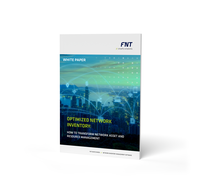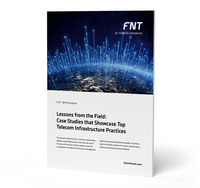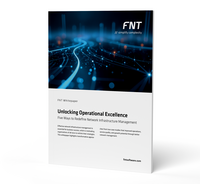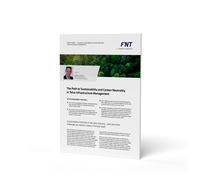FNT Software - Solutions for Communication Service Providers and Telecom Operators
We live in an on-demand world where everything that can be digitized, will be. Telecommunications networks are an important enabler in making this digital economy possible, reinforcing the need for carriers to evolve their infrastructure to ensure bandwidth and accessibility. Carriers that do so are able to give customers the competitive speeds and advanced digital services they demand.
Legacy OSS/BSS simply can’t handle today’s requirements. Meeting customer needs, generating revenue and increasing productivity in a digitally transforming world requires a modern and future-proof ICT infrastructure. Upgrading network infrastructure is the key to deploying the new technologies required for the digital future.
ㅤ
What Makes FNT Software Solutions Different?
- Centralized management of all network and service resources
- Tailored software packages for use cases specific to telecommunication networks
- Based on FNT Command, FNT's market-leading software for network documentation and infrastructure management
- Standardized, fully configurable software solutions with extensive out-of-the-box functionality
- Scalable functionality
- Wide range of visualization and analysis functionalities, including GIS capabilities
- Process management with workflow engine
- Open interfaces and integration options to facilitate automation and data exchange
- Available as a subscription-based model, so not big investment or maintenance fees required
FNT Solutions for telecommunication networks and services
Makes it possible to efficiently operate complex passive network infrastructures. It gives full transparency across the network to document, plan and manage any inside and outside plant cable network infrastructure. From a service assurance perspective, this is the best defense against service interruption. From a planning perspective, it ensures changes are based on accurate as-built documentation and that all changes are reflected in a centralized management system.
Delivers a vendor-agnostic, technology-neutral, single source of truth repository operators need to simplify planning and managing of the growing virtualized environment. Virtualized resources are deployed in large core data centers, distributed edge data centers and container sites.
Document and plan new sites, extend networks and modify existing sites with precise knowledge of all active and passive components in the telecommunications network.
Delivers and maintains an accurate and up-to-date inventory of all physical and logical network and service resources so providers can maximize the use of network resources in digital workflows.

Features and Functions (Click to expand)
- Dashboards and Reports: Configurable dashboards and reports provide information, make your team's performance transparent, improve and accelerate decisions.
- Integrated GIS Functionality In- and Outdoors: Network infrastructure data is enhanced with geoinformation to enable users to optimize its management inside, outside and between buildings.
- Definition of Self-Generated Reports: Custom database queries can be created and made available in the form of reports. Data can be accessed from your own Command database via a defined meta-schema. It is also possible to access external databases.
- Zone Management: Complex plant facilities are represented hierarchically, which includes campuses, plant buildings, floors, hall structures and rooms.
- User Management & Role Permissions: View and access to the database can be controlled. By assigning rights and privileges, an authorization concept is implemented.
- Accessory Management: Enables the management of individuals, groups, organizations, and contracts.
- Telecommunication Active Inventory: All types of transport network technologies, with seamless navigation throughout all hierarchical layers for immediate insights into all network connections, independent from underlying hardware technology.
- Mobile RAN Management: Stores configuration data for active nodes, passive infrastructure, and cells for all sites, from “candidate” status to “in operation".
- Asset & Order Management: IT assets can be efficiently managed and monitored throughout their entire lifecycle. Orders can be defined as sub-orders and assigned to various processing groups. The resulting workflows map the entire process.
- Workflow/Work Order Management: Planned changes are issued as detailed work orders to internal teams or external suppliers. Custom forms can be created to support and structure any workflow. The new actual state can be directly documented in the infrastructure repository.
- Interface Management: Data from other systems can be collected, reconciled, and made available for use across various applications within the enterprise.
- ETL Tool: Exchange, reconcile, and import large, heterogeneous data sets.
- Configurability: Extend existing standard entities with additional attributes and create new entities and assign them to other entities.
- Business Gateway: Provides extensive query and import options for both standard and dynamic entities and ensures integration with surrounding systems on the FNT Command Platform and external systems.
- Cable Management: Documentation, planning, and management of the entire network infrastructure. Components can be easily identified, issues quickly resolved, and future upgrades simplified.
- Connection Matrix: Logical connections between the ports on the A and B sides of an object can be created in any combination. This includes the interconnection of at least two devices and the internal wiring of modular devices, considering their specific nomenclature rules for ports and slots.
- Management of Splices and Junctions: Efficient management of splicing and junction functions within the network.
- Visualization of Infrastructure Elements on Room and Site Plans: Integrated graphical representation of objects in cluster views for a simplified understanding of the relationships within extensive networks.
- Signal Management: Comprehensive end-to-end view of transport paths through the documentation of signal route paths in the context of device and personnel data and their services.
- Autorouting: Create services with configurable routing criteria that identifies a set of available routes for a new service based on unused and planned logical resources.
- Regular and Spare Routes: Map redundancy and elasticity mechanisms, and use the documentation or service relations to map a primary path/secondary path assignment via technically independent services.
- Switching: Various switching functions are provided at the logical (bearer) and service levels to support grid expansion measures and grid transformations.
- Service Types: Document network and service resources with the highest level of detail through predefined service types for a wide variety of technologies.
- Transmission Technologies: Optical Transmission technologies can be documented using Circuit Switched Paths and Bearers and connections, which carry multiplexed traffic, can be sub structured.
- MPLS Services: Any services and their routings can be documented and mapped as Path or Multipoint Services with transmission technology packet data.
- Planning Function: Supports the planning of logical resources and services for setting up new, modifying and ending services. Planned and actual states as well as work instructions can be created, and logs can be managed.
- Product Bundles: Services, devices and other entities can be bundled into objects for targeted and simplified tracking in case of a failure. Products and their product assignments can be archived to retain assignment of objects to a product.
- Accessories: Telco-specific configurations such as service level agreement (SLA), quality of service (QoS) and traffic engineering rules (TER) can be assigned to services, in addition to standard FNT Command accessories such as contracts, persons, organizations.
Further Downloads
Would you like to learn more about FNT's solutions for Communication Service Providers and Telecom Operators? The following assets might be interesting for you:













